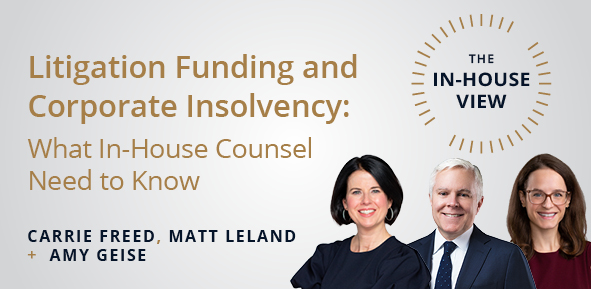Litigation Funding and Corporate Insolvency: What In-House Counsel Need to Know

- Author:
- Amy T. Geise
- Investment Manager and Legal Counsel - United States
‘The In-House View’ is a series by former in-house counsel, Carrie Freed, and commercial litigator, Matt Leland, discussing strategies for how legal departments can leverage litigation finance to create budget certainty, generate revenue, and manage litigation risk. This installment was co-authored by former bankruptcy attorney and commercial litigator Amy Geise.
Press reports are crowded with headlines about the rise in commercial bankruptcy filings, which increased yet again this year.1 High interest rates, inflation, delayed effects of COVID, and huge corporate debt contributed to the jump in corporate insolvency filings. More are anticipated.
In-house legal counsel are key members of corporate teams and are often responsible for managing credit and insolvency related risks faced by their organizations. Particularly when insolvency and litigation risks converge, in house lawyers play a critical role in helping corporations make strategic decisions to optimize value.
Whether these lawyers sit in the legal department of a company undergoing financial distress or provide legal advice to a creditor or a business partner of a distressed company, in-house counsel are responsible for providing their client company with comprehensive options to manage insolvency scenarios. In this context, these lawyers should be cognizant that litigation funding can provide the resources to maximize the value of existing claims and pursue new affirmative claims, even in situations involving financial distress and bankruptcy.
The following cases demonstrate how funding can provide unique and flexible solutions for both debtors with affirmative litigation claims and creditors with claims against insolvent corporations.
Funding Ongoing Litigation for a Company in Financial Distress
A company in financial distress generally looks to cut costs, restructure its balance sheet, and refinance its existing debt. Austerity measures may include cutting legal expenses—particularly any that are considered non-critical to the company’s operations. But what if the company has a valuable affirmative litigation claim that might yield a substantial payday, even if the case is years away from a resolution? Of course, the prospect of a valuable future recovery may only matter if the company can navigate its current financial situation, as some claims can take years to resolve.
Litigation funding can offer the company a way to preserve that litigation asset, either through an upfront monetization of the claim based on the anticipated future recovery, or by funding the ongoing legal fees and expenses associated with pursuing the claim in exchange for a return out of any future recovery. Whether funding adds money to the company’s balance sheet or reduces ongoing legal costs, the company will recognize immediate value in preserving or gaining liquidity.
Debtor in Possession (DIP) Funding
Litigation funding can also provide operating capital to assist companies in bankruptcy. Most often, this type of funding comes through a traditional DIP loan collateralized by cash and other tangible company assets. However, if a debtor has litigation assets and is unable to obtain traditional recourse financing, litigation funding can offer an alternative source of liquidity. Moreover, because litigation funding is a non-recourse cash advance collateralized only by future litigation recoveries, the senior secured lender preserves its priority position on the debtor’s hard assets. Like the first scenario, litigation funding can provide an upfront monetization of the asset or provide capital to pay legal fees and expenses. Funding can also be provided to pay restructuring or operating expenses depending on the size of the potential future litigation recovery.
Funding for Bankruptcy Trustees
Litigation funding also has a key role to play post-confirmation. For example, often the only value remaining for creditors is a handful of affirmative claims placed into a litigation trust. A bankruptcy trustee has a fiduciary obligation to protect the interests of all beneficiaries of the trust but may have a limited ability to pursue them. Litigation funding can fill this gap by providing the necessary capital to pursue claims within a litigation trust. The funder only receives a return if the litigation is successful, and the creditors benefit from the trustee’s ability to litigate claims that would have otherwise been too costly to pursue.
Monetization of a Creditor Claim in Bankruptcy
Another way that litigation funding can bring value to creditors is by providing a mechanism for a creditor to monetize its affirmative claim against a debtor. For example, take a company that has claims—either known or contingent—against a company or companies going through bankruptcy. If these claims have sufficient value, a litigation funder may be able to monetize them immediately, rather than the creditor having to wait potentially years for the claims administration process to conclude. In this scenario, funding allows a creditor to recognize the vital value of future known or contingent claims while reducing the risk and uncertainty that comes with a drawn-out claims resolution process.
As these examples illustrate, insolvency situations involve dynamic landscapes that present opportunities for in house lawyers to strategically utilize litigation funding for the benefit of their organization. Whether funding is provided to distressed or insolvent companies or to their creditors, in-house counsel can successfully navigate this landscape by transforming affirmative litigation claims into assets.
[1] Epiq Global. (2024, April 2) Bankruptcy Filings Increase Across All Chapters in First Quarter 2024: Commercial Chapter 11s Up 43 Percent. Epiq News. LINK.